-
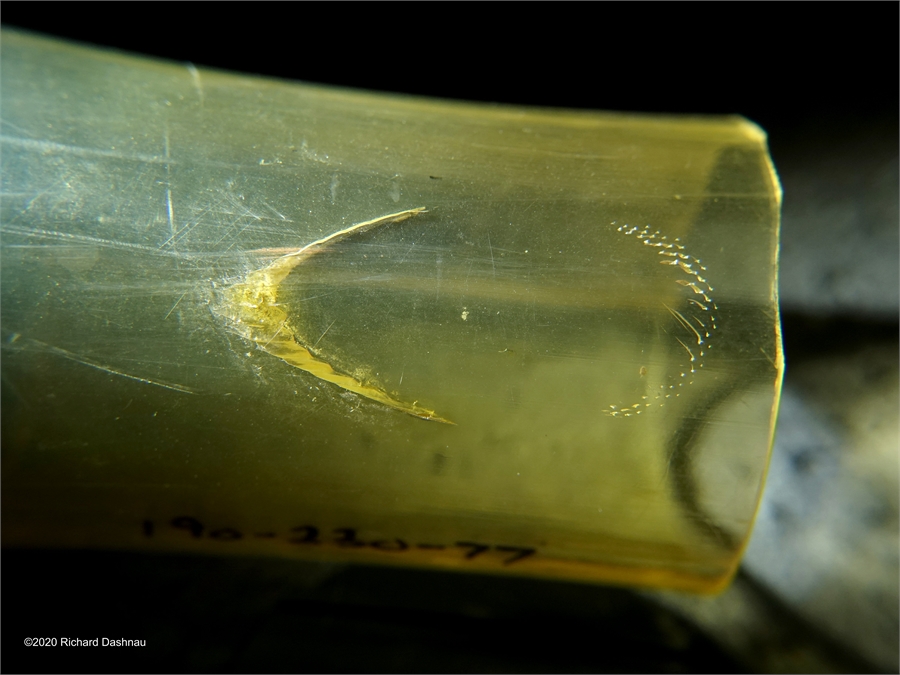 -
-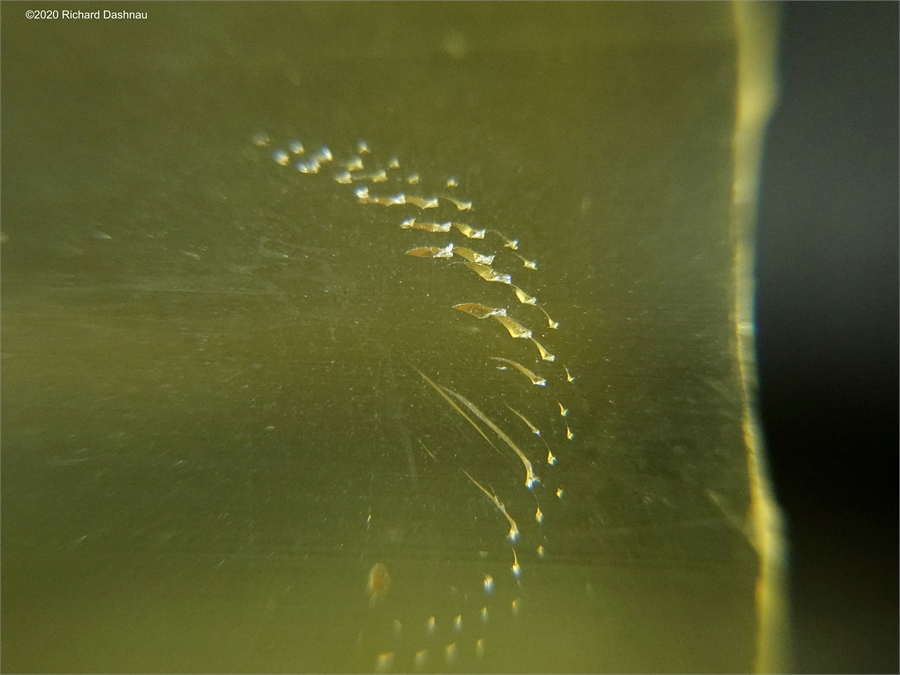 -
-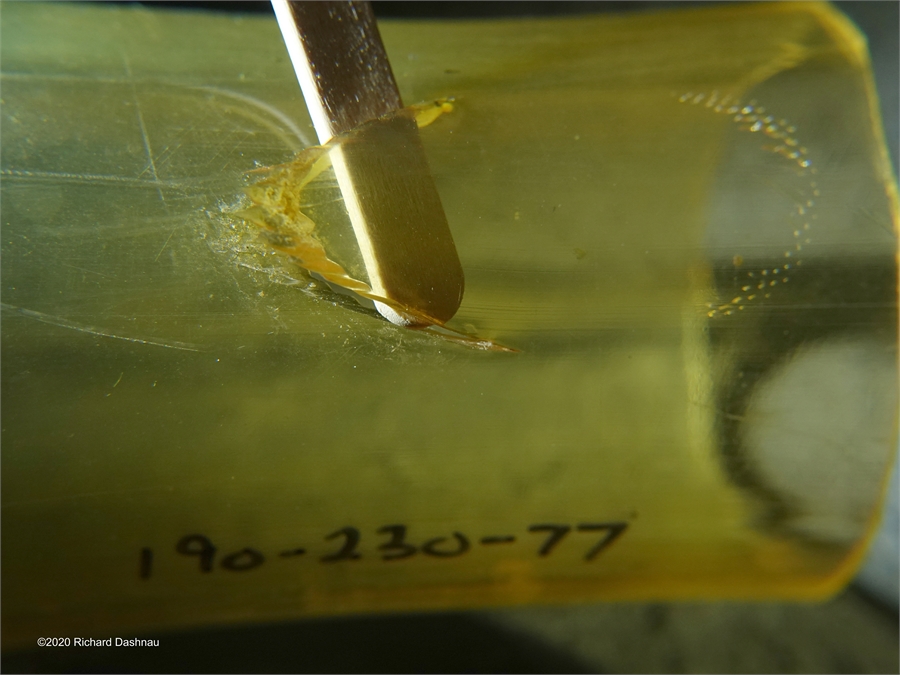 -
-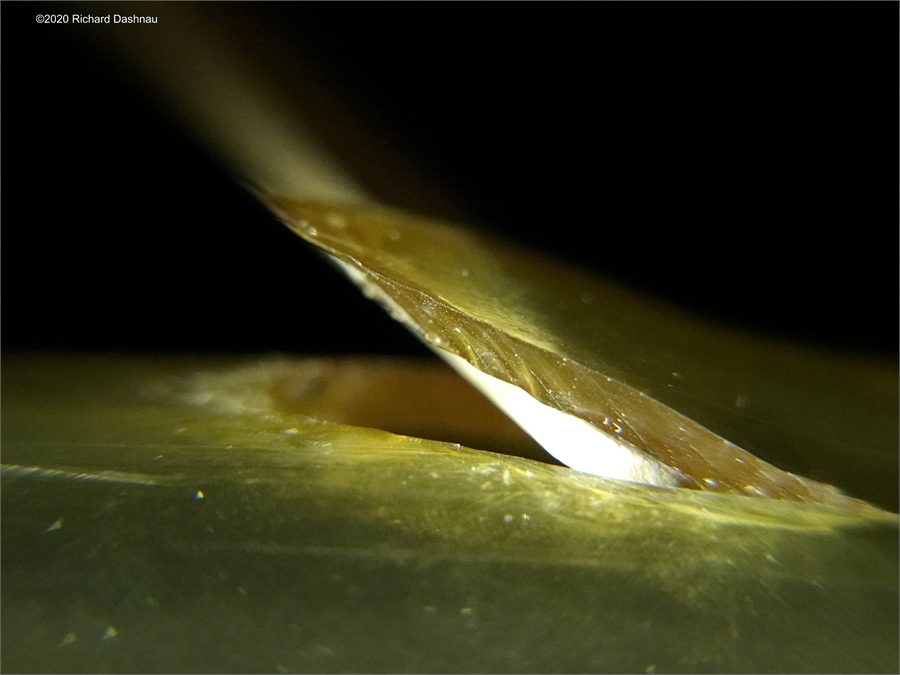 --
--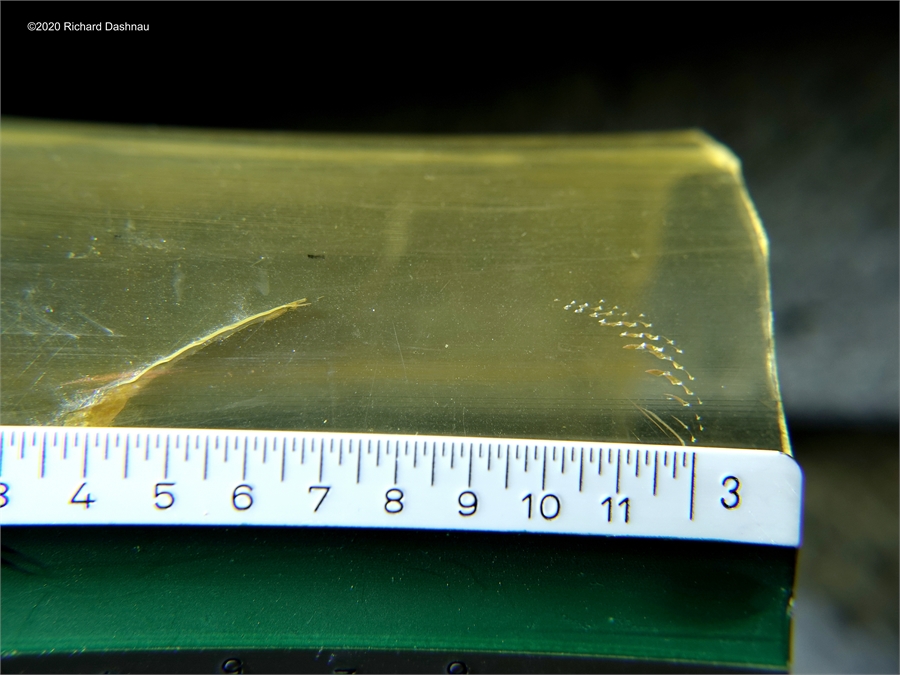 -
-New update,
4/11/2020. A few weeks ago, I was surprised when I got serious
inquiry about the images on this page. I still have my original
samples (which I'd gathered in 1991). I
decided to shoot new
photos of those samples. Armed with a better camera than was
available to me in 2001 (when I'd taken the first images) I shot more
photos. This was more difficult
than I thought it would be. Since the
samples are nearly transparent it's difficult to focus on details on
their outside surface. I finally got better results by lighting them
from the end. The
jacket material (which is urethane, about 3mm
thick) acts as a light guide, and light transmitted between the flat
surfaces strikes imperfections and illuminates them. I have
picked my best
images
for inclusion here. The images that show are 900 x 675,
--but if you click on one you will get a MUCH larger image. The big
file sizes are much, much larger than the images I
usually post. I'm sure this will cause this page to load slowly, but I
thought curious visitors would appreciate the opportunity to take a
closer look. By the way, there's a possibility that at
least some
of my samples may be appearing on public display as part as a
larger presentation in a museum piece. I'll see how that goes a
bit later (this was part of the original inquiry).
The new images are
directly below. I have 10 samples left (after 29 years!!). I've
saved the original content of this page and placed it further down,
below the double-line (it details the
history of these samples). The scale shown in the new images is
in 1/4 increments. That is, the distance between each of the numbered
marks is 1/4 inch. It's the only precise scale I had
at home at the
time. The arrow on some of the samples indicates the direction the
cable would have been moving while being towed. But,the sharks might have
hit the cables if the boat had
stopped. The deeper cuts would
have been made by the teeth in the bottom jaw, while the tiny holes and scratches
are probably marks made by the small "teeth" in the upper jaw. Circular
scratches may show how the shark was pulled off by the flow of water
during towing, or may show how the shark works to pull out a plug. When I first shared this page, it was difficult to find
any
information about cookie-cutter sharks on the internet. Search
now, and you'll find all kinds of images, and even some video clips of
them swimming!
===============================================================================================================================================
First post--1/29/2001
Clicking on some of the images
in this page will enlarge that image. I kept them all at 320x240.
The
year was 1991. The company I worked for was repairing hydrostreamers being
used in the Gulf of Mexico. The cables
are
quite long, and are towed behind seismic survey boats. We began seeing
a lot of cables coming in with very odd damage to the plastic skin. This
skin, by the way, is very tough. It's hard
to cut with a knife, and hard
to puncture. Since these cables are used in the oceans, we've seen many
kinds of damage. I've seen cables obviously bitten into by sharks. I found
a shark's tooth
at one time. Cables get torn on reefs and oil rigs. I still
have a tooth that probably belonged to a seal at one time, that I found
in another cable. The damage on this occasion, however, was
something
we'd never seen before. or, if we had, we'd assumed it was something else.
Although there was some variation in the marks, there were enough similarities
between them to
show that they probably had a common source. These two
images are of what I'd call the "classic" damage mode. That is, most of the bites looked like these.
-----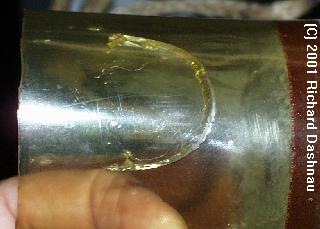 ---
---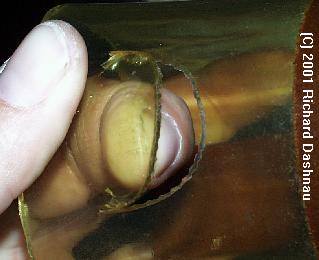 -
-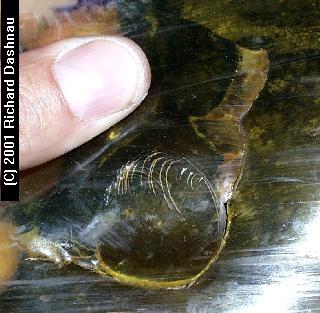 -
-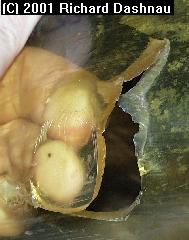
All images in this section were
taken 01/29/2001, but all of these are samples that I saved from back in
1991. The following images show further examples of the damage
we encountered.
Most of them are in pairs, showing two views of each cut.
The holes definitely looked
like something living had made them, instead of being the result of being dragged
across an object. Also,
the serrated nature of the cuts was interesting
to me. Notice the peculiar scratches on the top surface of the flap
above. These marks occur in other examples as well.
-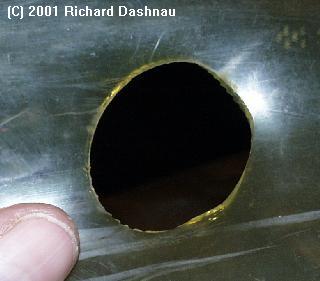 -
-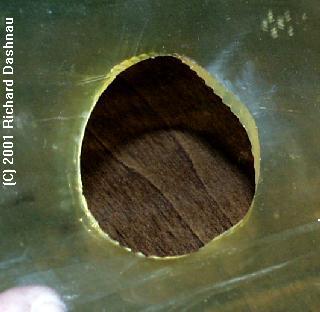 -
-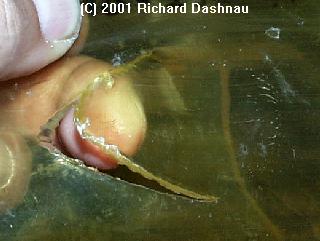
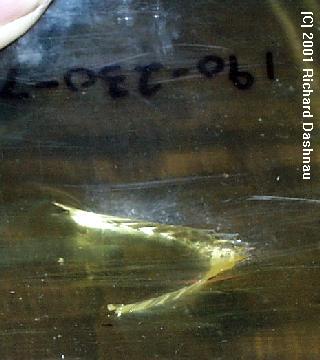
The hole shown in the two
views above was a rare occurrence--that of an entire plug pulled
out. The image above right,
however, was another type.
There was a small subset of these marks
that showed this definite "v" shape, as opposed to the circular shape shown in the first two images at the top
of the page. Another example is shown below.
------------------
--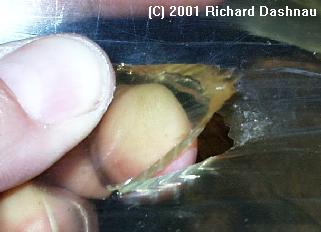 -
-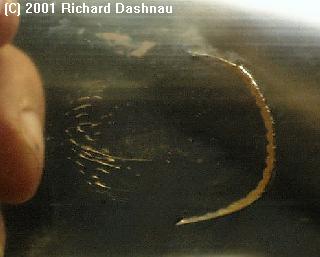 --
--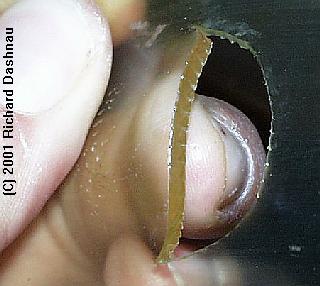
And then, finally, two more
images of a "classic" cut in the skin. Those little scratches, or nicks
directly opposite the cut are evident here, as well.
So, we kept getting these
sections in at the latter part of 1991. Then, in one of those flashes of
inspiration that doesn't happen enough. An image popped into my mind of
a book I'd looked
through maybe a year or so before. I went back through
all the bookstores I could think of (this is where I probably would have
seen it.), and I finally did find the image. This was on page 27
in the
hardcover book, "Sharks--Silent Hunters of the Deep" ((C)1987 Reader's
Digest Services ISBN 0 86438 014 3). The image was actually
a small sidebar on that page, and it referred
to what is called a "cookie-cutter
shark". The sidebar mentions an incident where the US Navy encountered
strange damage on their rubber-covered listening devices. There were two
photos. One was of a very nasty-looking sharp-toothed critter (which looked
nothing a shark); and the other was of the damage done. A crescent-shaped
tear in the rubber. Bingo! I knew I'd
found the culprit.
Chances are good that as you
read this, you are shaking your head, thinking I'm writing another joke.
Well, when I went back to work and told my theory to my boss, his boss,
and my coworkers, they didn't really believe me, either. We didn't have
the access to information that the internet gives us now (Imagine that!
Just 9 years, and look what we can find now!).
Well, there
was nothing for it but for me to buy the book, and show everyone. Then,
a fax was sent to the Gulf of Mexico Fishery Management Center, after some
other people made some
phone calls. The image below left was the part of
the fax that was sent. The image below center was the first reply. Then,
someone involved in all this-I'm not sure who- contacted Dr. Jose
Castro,
at the Southeast Fisheries Center. The image below right was
his reply. He was also kind enough to fax some pages from his book, "The
Sharks of North American Waters" (Texas
A+M University Press). Later,
I sent him a few samples of the skin, and also, a video tape I'd taken
of the majority of the samples. (Have I mentioned that having a digital
camera can really
make life easier?) I've just had an email correspondence
with Dr. Castro, and got his permission to credit him here. So, thank you
Dr. Castro, for sharing your knowledge. (What can I say? I
doubt that all
scientists would take the time to talk to me.)
---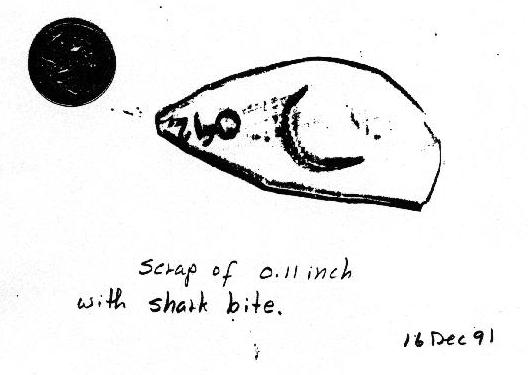 ---
---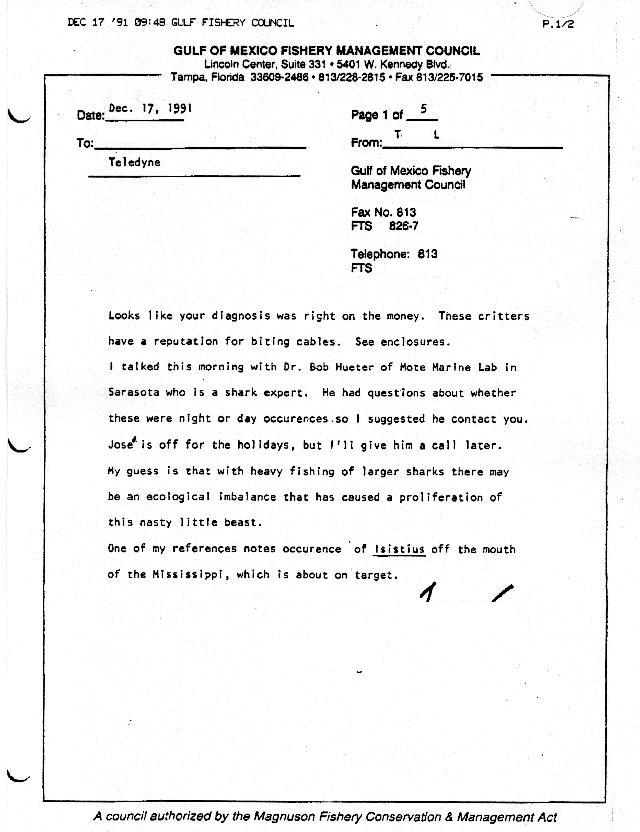 ---
---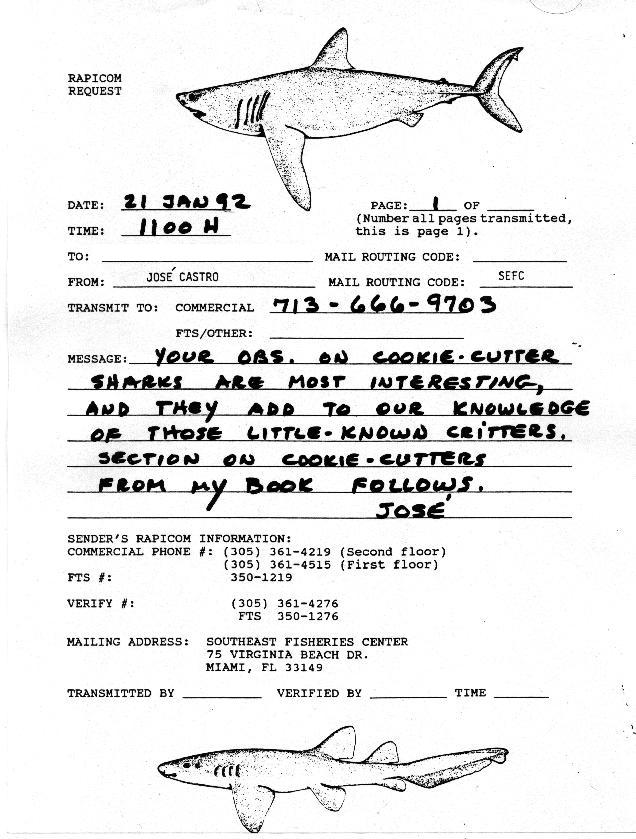
So, just what is
a "cookie-cutter" shark? Well, I'll paraphrase from the books I've mentioned
above . From these sources, I gather that there are actually 2 species
of "cookie-cutter". The
first is
Isistius Braziliensis; and
the second is Isistius Plutodus. The first half of the name refers
to Isis, the goddess of light, since both of these sharks glow. These sharks
get no longer than
50 cm long (around 20 inches). They are generally moderate
to deep-water sharks (depending on the species), and Braziliensis is
thought to make a daily migration of 1 mile--that is up and
down.
Nothing "cookie-cutterish" in all of this, is there? Well, now comes
the good part. The lower jaw of these sharks contains huge teeth, that
are, in effect, joined into a single curved
structure. This looks exactly
like a cookie cutter (well, one with really nasty points.). It gets even
more interesting, though. What these sharks do, is swim up to larger animals
(sharks, whales,
seals, dolphins, tuna, etc.). Then, the shark latches
on with its suckerlike mouth, and twists until it pulls off a circular
plug of flesh (remember the hole in the cable skin above?) very much like
a
cookie-cutter would do. These sharks are poorly built as swimmers, at
least compared to the predators that they seem to attack. It has been conjectured
that the the cookie-cutter shark's
luminescence actually acts as a lure.
Then, when the larger predatory species doesn't find food (Who knows? Perhaps
the shark can "turn off" its light. I'm guessing, here.), and passes by,
or
turns away, the cookie-cutter makes its move.
===============================================================================================================================================
Here are some links to follow (to pages that *aren't* mine) to learn more about these sharks. Some of them have some photos, too.
1. Florida Museum of Natural History: Cookie-Cutter Shark
2. Marine Bio: Cookiecutter Shark
for more information on sharks in general:
3. Southeast Fisheries Science Center
4. Ichthyology at the Florida Museum of Natural History --Lots of information.
5. Reefquest Center for Shark Research --This huge website has tons of information!
I can't say that I spend
all my time seeking out nature and biological secrets. But, I do make the effort to do this
at least sometimes. Before I noticed the weird holes, and did some
investigating,
I'd never heard of this bizarre animal. Now, I've had a chance to pass
on this knowledge. I didn't discover the animal, but it was new to me.
It might have been new to you, also.
I like to see
the world.
Who
knows anymore? It looks like my hit counter has gone away...after
about 20 years. The current opinion seems to be that hit counters are
outdated. But it was kind of nice to see if
anyone was visiting.
5/20/2020
Click here to go back
to "see the world".
Click here to go back
to my main page.